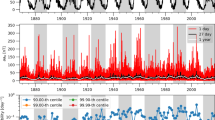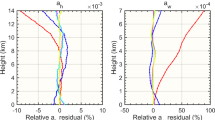Abstract
Analytical continuation of gravity anomalies and height anomalies is compared with Helmert's second condensation method. Assuming that the density of the terrain is constant and known the latter method can be regarded as correct. All solutions are limited to the second power of H/R, where H is the orthometric height of the terrain and R is mean sea-level radius. We conclude that the prediction of free-air anomalies and height anomalies by analytical continuation with Poisson's formula and Stokes's formula goes without error. Applying the same technique for geoid determination yields an error of the order of H2, stemming from the failure of analytical continuation inside the masses of the Earth.
Similar content being viewed by others
References
Bjerhammar, A. (1962): Gravity reduction to a spherical surface. Royal Institute of Technology, Division of Geodesy, Stockholm.
Bjerhammar, A. (1963): A new theory of gravimetric geodesy. Royal Institute of Technology, Division of Geodesy, Stockholm.
Bjerhammar, A. (1964): A new theory of geodetic gravity. Royal Institute of Technology, Division of Geodesy, Stockholm.
Bjerhammar, A. (1969): On the boundary value problem of physical geodesy. Tellus XXI, 4.
Bjerhammar, A. (1975): Discrete approaches to the solution of the boundary value problem in physical geodesy. Boll. Geod. Sci. Affini, Vol. 34, pp. 185–240.
Bjerhammar, A. and L. Svensson (1979): The convergence of harmonic reduction to an internal sphere. Bull. Géod., Vol, 53, pp. 247–257.
Helmert, F.R. (1884): Die mathematischen und physikalischen Theorien der höheren Geodäsie, Vol. 2, B.G. Teubner, Leipzig.
Heiskanen, W. and H. Moritz (1967): Physical Geodesy. W.H Freeman and company, San Fransisco and London.
Krarup, T. (1969): A contribution to the Mathematical Foundation of Physical Geodesy, Meddelelse No. 44, Geodaetisk Institut, Copenhagen.
Moritz, H. (1966 a): Methods for downward continuation of gravity. DGK, Series A, Vol. no. 50, Munich.
Moritz, H. (1966 b): Linear solutions of the geodetic boundary value problem. The Department of Geodetic Science Report, No. 79, The Ohio State University, Columbus, Ohio.
Moritz, H. (1980): Advanced Physical Geodesy. Herbert Wichmann Verlag, Karlsruhe
Sjöberg, L. E. (1994): On the terrain effects in geoid and quasigeoid determinations using Helmert's second condensation method. Division of Geodesy Report No. 36, (TRITA-GEOD 1036), KTH, Stockholm.
Sjöberg, L.E. (1995 a): On the quasigeoid to geoid separation. Manuscripta Geodaetica, Vol. 20, pp. 182–192.
Sjöberg, L.E. (1995 b): On the downward continuation error at the Earth's surface and the geoid of satellite derived geopotential models. Submitted to Manuscripta Geodaetica.
Wang, Y. M. (1990): The effect of topography on the determination of the geoid using analytical down-ward continuation. Bull. Géod., Vol. 64, pp. 231–246.
Wang, Y. M. (1995): On the error of analytical downward continuation under planar approximation. Manuscripta Geodaetica, Vol. 20, pp. 34–45.
Author information
Authors and Affiliations
Rights and permissions
About this article
Cite this article
Sjöberg, L.E. On the error of analytical continuation in physical geodesy. Journal of Geodesy 70, 724–730 (1996). https://doi.org/10.1007/BF00867150
Received:
Accepted:
Issue Date:
DOI: https://doi.org/10.1007/BF00867150




